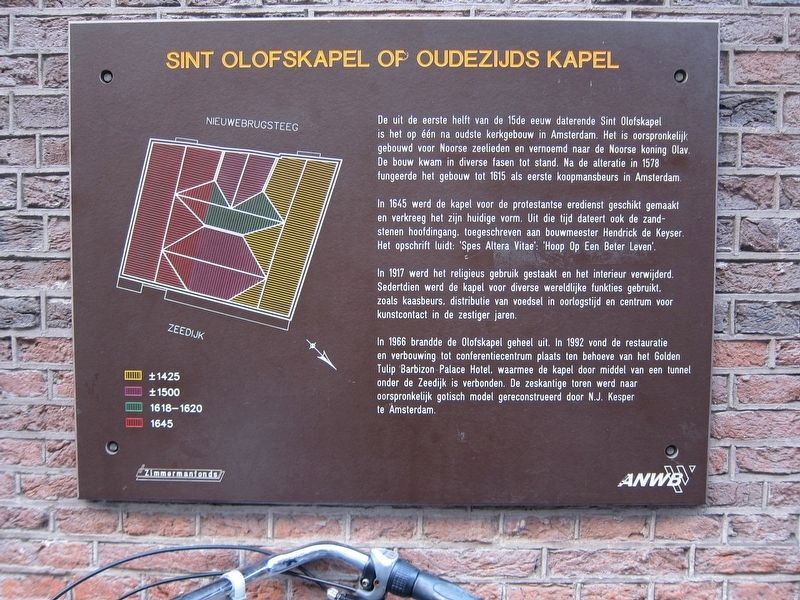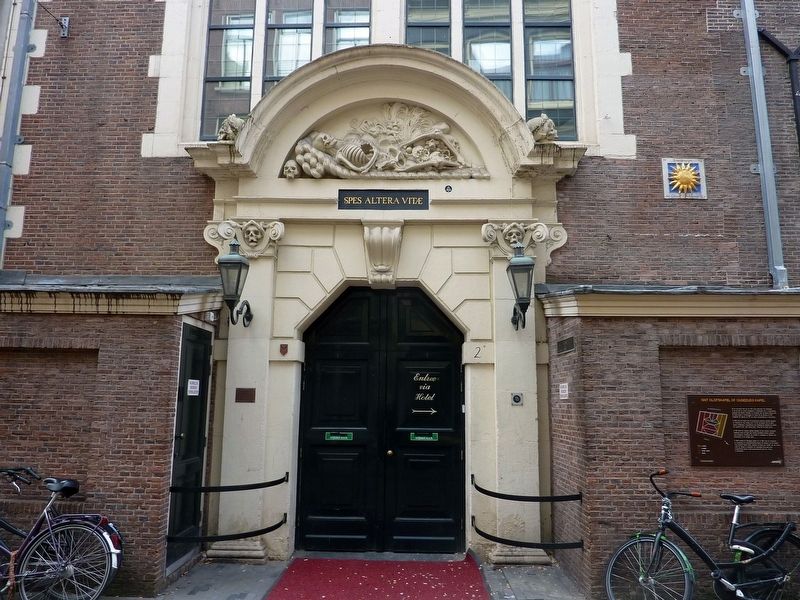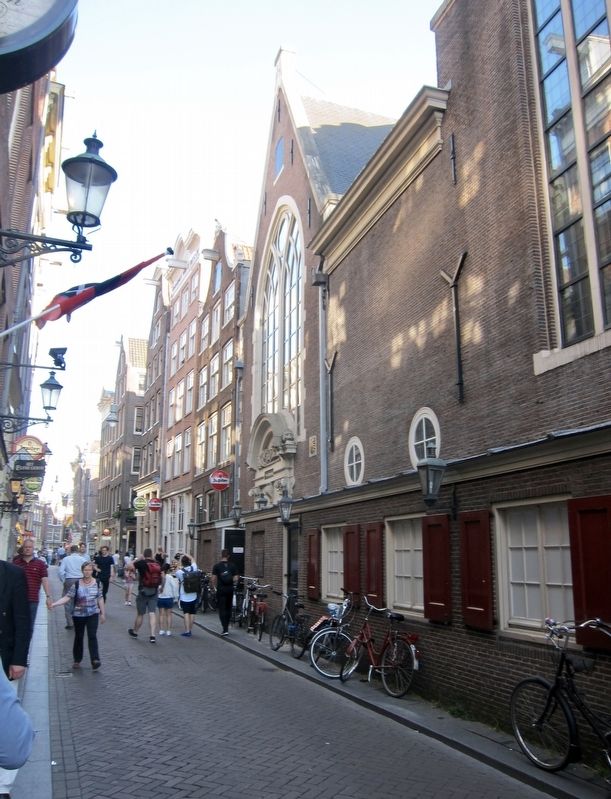Binnenstad in Amsterdam, North Holland, Netherlands — Northwestern Europe
Sint Olofskapel / Saint Olof's Chapel
Inscription.
De uit de eerste helft van de 15de eeuw daterende Sint Olofskapel is het op één na oudste kerkgebouw in Amsterdam. Het is oorspronkelijk gebouwd voor Noorse zeelieden en vernoemd naar de Noorse koning Olav. De bouw kwam in diverse fasen tot stand. Na de alteratie in 1578 fungeerde het gebouw tot 1615 als eerste koopmansbeurs in Amsterdam.
In 1645 werd de kapel voor de protestantse eredienst geschikt gemaakt en verkreeg het zijn huidige vorm. Uit die tijd dateert ook de zand-stenen hoofdingang, toegeschreven aan bouwmeester Hendrick de Keyser. Het opschrift luidt: 'Spes Altera Vitae': 'Hoop Op Een Beter Leven'.
In 1917 werd het religieus gebruik gestaakt en het interieur verwijderd. Sedertdien werd de kapel voor diverse wereldlijke funkties gebruikt, zoals kaasbeurs, distributie van voedsel in oorlogstijd en centrum voor kunstcontact in de zestiger jaren.
In 1966 brandde de Olofskapel geheel uit. In 1992 vond de restauratie en verbouwing tot conferentiecentrum plaats ten behoeve van het Golden Tulip Barbizon Palace Hotel. waarmee de kapel door middel van een tunnel onder de Zeedijk is verbonden. De zeskantige toren werd naar oorspronkelijk gotisch model gereconstrueerd door N.J. Kesper te Amsterdam.
Dating from the first half of the 15th Century, Sint Olofskapel (Saint Olof's Chapel) is the second oldest church building in Amsterdam. It was originally built for Norwegian sailors and named after King Olav of Norway. The construction was completed in various phases. After alterations in 1578, the building served until 1615 as the first merchant trade hall in Amsterdam.
In 1645, the chapel was altered for Protestant worship and took on its current form. The sandstone main entrance dates from that time, attributed to the architect Hendrick de Keyser. The inscription reads: 'Spes Altera Vitae': 'Hope for a Better Life'.
In 1917, religious use was discontinued and the interior was removed. Since then, the chapel has been used for various secular functions, such as cheese fairs, the distribution of food in wartime, and as a center for the arts in the 1960s.
In 1966, a fire completely gutted the interior of the Olofskapel. In 1992 the restoration and conversion to a conference center took place, making it part of the Golden Tulip Barbizon Palace Hotel, with which the chapel is connected by means of a tunnel under
Zeedijk Street. The hexagonal tower was reconstructed according to the original Gothic model by N.J. Kesper of Amsterdam.
Erected by Zimmermanfonds, ANWB.
Topics. This historical marker is listed in these topic lists: Churches & Religion • Industry & Commerce. A significant historical year for this entry is 1578.
Location. 52° 22.57′ N, 4° 54.01′ E. Marker is in Amsterdam, Noord-Holland (North Holland). It is in Binnenstad. Marker is on Zeedijk just south of Prins Hendrikkade, on the left when traveling north. Touch for map. Marker is at or near this postal address: Zeedijk 2, Amsterdam, Noord-Holland 1012 AX, Netherlands. Touch for directions.
Other nearby markers. At least 8 other markers are within walking distance of this marker. Chet Baker (within shouting distance of this marker); Majoor Bosshardthuis (within shouting distance of this marker); " 'T Saligh Roemers Huys / The Delightful House of Roemer (about 120 meters away, measured in a direct line); Joost van den Vondel (about 120 meters away); Schreierstoren (about 150 meters away); Henry Hudson (about 150 meters away); Bet van Beeren (about 150 meters away); Jan Pietersz Sweelinck (about 150 meters away). Touch for a list and map of all markers in Amsterdam.
Also see . . .
1. Sint Olafskapel (IAmsterdam). "The original Sint Olofskapel (Saint Olof’s chapel) was built between 1440 and
1450, making it the oldest chapel in Amsterdam. It was built in honor of saint was Saint Odulphus from the Dutch province of Brabant – the patron saint of the dykes...." (Submitted on February 4, 2018.)
2. Sint Olofskapel (Wikipedia, in Dutch). (Submitted on February 4, 2018.)
Credits. This page was last revised on February 3, 2023. It was originally submitted on February 4, 2018, by Andrew Ruppenstein of Lamorinda, California. This page has been viewed 390 times since then and 36 times this year. Photos: 1, 2, 3. submitted on February 4, 2018, by Andrew Ruppenstein of Lamorinda, California.


